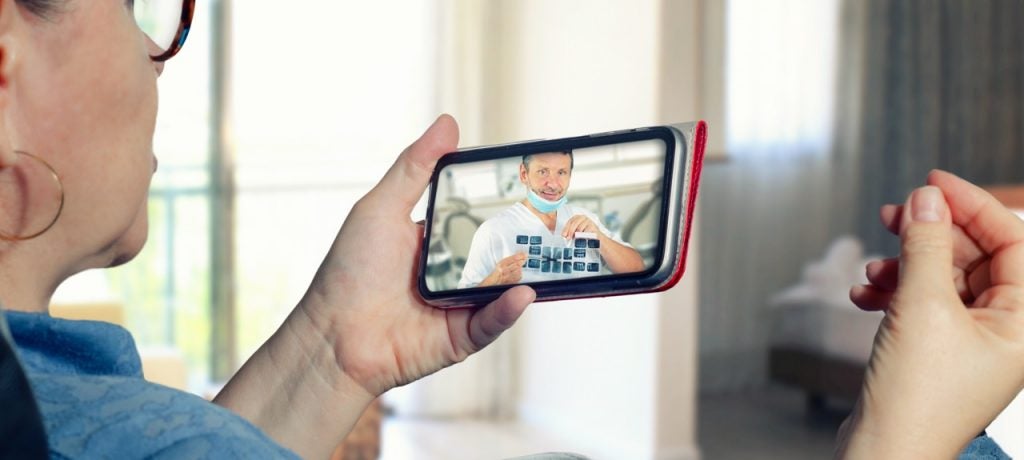Information Library
Start Reading

Many people experienced teledentistry for the first time during the pandemic in 2020.
First used by NASA in the 1970s and by the U.S. military in the 1990s, teledentistry “served as a boon for … dentists to manage dental emergencies during the lockdown.” Because patients and providers weren’t in the same location, teledentistry visits carried no risk of viral exposure or contagion.
Even before the pandemic, however, patients in rural areas, in low-income areas, with disabilities, and others had been experiencing the benefits of teledentistry. The circumstances accelerated the adoption of an already proven, productive mode of oral health care.
We at Penn Dental Medicine (PDM) had already been using teledentistry when appropriate. We increased our teledentistry offerings in 2020 and continue to use it to deliver sophisticated, patient-centered care to those unable, for whatever reason, to visit us in person.
Keep reading for answers to some questions our patients ask about teledentistry.
 What is teledentistry? It is the use of video and audio telecommunications technology to remotely diagnose and provide guidance about treating dental and oral health issues. It is a subfield of telehealth, which encompasses a broad range of healthcare services delivered virtually.
What is teledentistry? It is the use of video and audio telecommunications technology to remotely diagnose and provide guidance about treating dental and oral health issues. It is a subfield of telehealth, which encompasses a broad range of healthcare services delivered virtually.
Think of teledentistry as your dentist’s virtual office, accessible from your home. It uses live video, video-conferencing technologies, and secure electronic communication systems to deliver quality dental care outside the traditional physical setting. Such care can include everything from consultations and diagnoses to remote monitoring of orthodontic treatment.
The benefits of teledentistry make it a significant advancement in how dental professionals connect with and care for patients.
For example, it bridges geographical gaps by connecting patients with licensed dentists regardless of location. This connectivity especially matters in situations where people lack immediate access to a dentist, such as in rural areas. Four in 10 adults living in rural areas haven’t visited a dentist in more than a year, and 67% of rural areas have a shortage of dental health professionals.
This increased accessibility also extends to individuals with mobility limitations or time constraints. It offers a convenient alternative to traditional in-office visits.
For instance, a working parent can schedule a virtual consultation during their lunch break, eliminating the need for travel and time off. This convenience promotes preventative care and addresses minor issues before they escalate.
Your dentist can help you with several issues during a teledentistry visit.
During your session, you will be able to share what type of dental problems you’re experiencing.
Your dentist will have full electronic access to your medical history, dental X-rays, and other pertinent health records.
Based on your records and a virtual dental examination, your dentist may be able to recommend a treatment plan. You can even do some treatments at home with your dentist’s guidance.
Remote dental visits with the oral health care experts at PDFP are available to you if you have a stable, medium-to-strong internet connection (for example, a 4G or 5G connection, or a reliable Wi-Fi network) and one of the following:
 PDM is committed to and vigilant in upholding patient privacy standards.
PDM is committed to and vigilant in upholding patient privacy standards.
For instance, we use encrypted messaging and secure file transfer systems to transmit patient records and maintain data integrity. We comply with HHS guidance that entities covered by the HIPAA Privacy Rule must “apply reasonable safeguards to protect the privacy of protected health information (PHI) from impermissible uses or disclosures, including when providing telehealth services.”
Also, note that we use only secure, end-to-end encrypted platforms for telemedicine, not such public-facing platforms as Facebook Live, Twitch, or TikTok.
 In urgent dental situations, teledentistry can be a valuable tool for initial assessment and guidance. Obviously, however, some dental conditions cannot be treated remotely.
In urgent dental situations, teledentistry can be a valuable tool for initial assessment and guidance. Obviously, however, some dental conditions cannot be treated remotely.
A teledental appointment may determine that you need to be seen by an emergency dentist. Emergencies necessitating urgent dental care may include:
These conditions do not represent all dental emergencies. If you are experiencing severe pain, swelling, and other types of discomfort, please call us at 215-898-8965.
Many health and dental insurance companies do reimburse telehealth visits. At PDM, we are proud to offer our patients telehealth consultations at no extra charge.
Whether we see you remotely or in person, we are always committed to your dental health and wellness.
Staying informed and proactive about your oral health is key to your brighter, healthier smile. Make your appointment now online or call us at 215-898-8965.